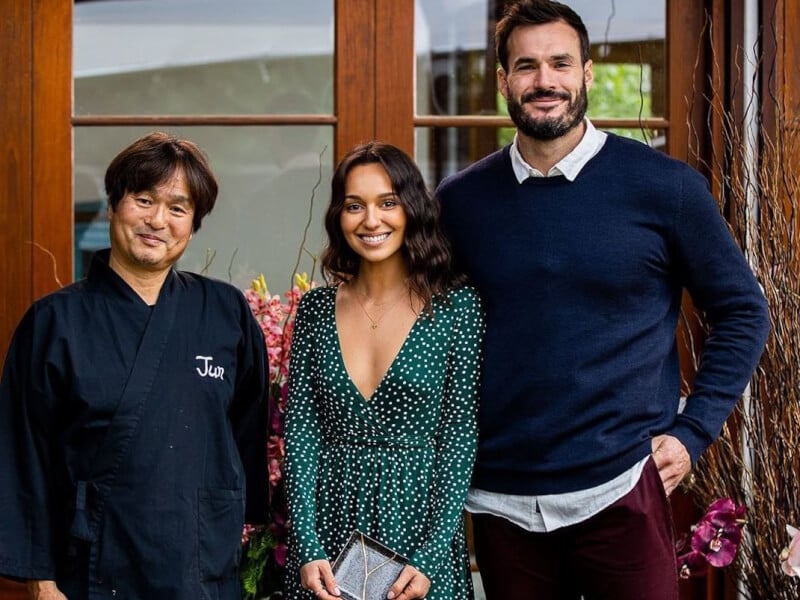In this story:
An episode of The Bachelor was the last place I expected to see two people learning the ancient Japanese craft of Kintsugi. There to guide the contestants was Jun Morooka, Japanese craftsman and founder of Kintsugi Australia, a community workshop studio based in Sydney.
“In Japanese ‘Kin’ means gold and ‘Tsugi’ means to join together,” says Jun, who is on a mission to share this Japanese craft across Australia.
As it turns out, this traditional method for repairing ceramics doubles as a powerful symbol for healing and embracing the beauty of imperfection – something I discover a few months later in one of Jun’s classes. While carefully mending my own floral pink plate alongside my partner, I begin to understand the four lessons this centuries-old craft has to teach us about life, love and healing in the 21st century.
1. Don’t discard what’s broken
Things are broken every day, and while it’s easy to beat yourself up over the breaking, it’s actually what comes afterwards that matters. Instead of sweeping up and discarding the pieces, what if I told you that you could actually put them back together to create something even more beautiful?
Enter: Kintsugi, a craft that originated during the Muromachi period in Japan, under the shogunate (a military ruler appointed by the Emperor), Ashigaka Yoshimasa. While vigorously filing down the edges of our broken pieces, Jun explains to us that after Yoshimasa accidentally cracked his favourite pottery piece, he sent it to experienced Chinese ceramicists to be repaired. No one had the skill to piece it back together, so it was returned to him with a clamp holding it together. Yoshimasa wasn’t happy with the quick fix, so he demanded the Japanese craftspeople find a better solution. By combining local tree sap and shimmering gold dust, they found the answer.
This Kintsugi philosophy reminds me that even when the going gets tough, with a little patience (the filing certainly demands it), love and attention, you’ll come out the other side a little different but no less beautiful.

2. Share your healing journey
Society has conditioned us to cover our scars and conceal our struggles. Kintsugi, however, goes against the grain and brings these flaws into focus. Our lives are ever-changing, so we are bound to experience hardships and experience a few breaks along the way. Kintsugi teaches us to embrace this journey – the good and the bad – because it contributes to who we are today.
“You can rediscover the beauty and value of the broken goods while taking each repairing step," Jun says, recalling his favourite white stoneware Kintsugi bowls, now on display at Sydney Adventist Hospital. "Humans are the same.”
As we’re ready to begin glueing our broken pieces back together, it hits me how timeless this traditional craft is.

3. Reframe hardship as an opportunity
Kintsugi is proof that some things are even more beautiful for having been broken. In life, love and relationships, often it’s the challenges that make us stronger and allow us to rebuild.
This idea starts to sink in as I’m glueing my four broken pieces back together and filling in any gaps with putty. I can’t see it yet, but I have faith that this small plate is going to be even more beautiful and captivating than before.

4. Admire your imperfections
Wabi-Sabi is the Japanese philosophy that centres around appreciating the beauty that is imperfect, impermanent, and incomplete in nature. It’s prevalent in all forms of Japanese art, especially Kintsugi.
This philosophy rings true as we make it to the final step in the class – the one that brings the entire heart of Kintsugi together. Surprisingly, sprinkling and scattering gold dust across the thin web of glue is the most simple part of the whole process. And yet, this gorgeous, shimmering result is only achieved through the more tedious and gritty work, like filing the edges and scraping off the overflowing putty that oozes from the cracks in the plate.
After peeling back the tape to reveal the final result, all eyes are on the glistening gold veins. It’s the first time I’ve appreciated and admired the scars of a piece before the rest of it. My partner and I exchange a glance, some unspoken agreement that with every challenge we face together we’ll keep this imperfectly beautiful reminder in the back of our minds.
Jun leaves us with some final words of wisdom, “Our body and heart can be repaired like Kintsugi ceramics too.” The class not only leaves us with a one-of-a-kind ceramic, but a whole new perspective.
Not all things in life can be mended with bright gold seams, but Kintsugi is a good reminder that, no matter how broken you may feel, with patience, hard work and acceptance, you’ll soon become whole again.

Resources
1) How samurai, statesmen, and scholars shaped the Japanese tea ceremony, National Geographic
2) The Ancient Craft Of Kintsugi Continues To Fascinate Contemporary Artists, Forbes
3) kintsugi-australia.com.au




















